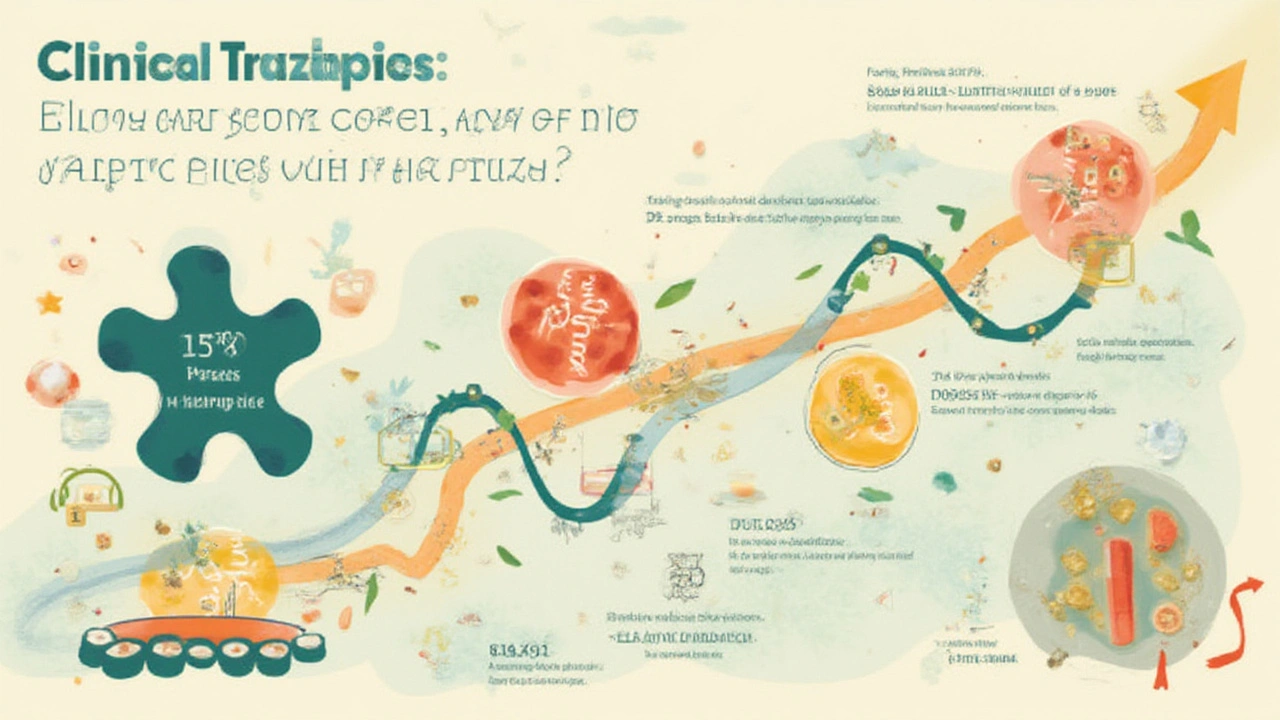Picture this: it’s pollen season, you’re desperate for relief, but every allergy tablet turns you into a sleep-deprived zombie. Sound familiar? Now, the world of allergy medicine is buzzing about a new wave of tablets that target allergic rhinitis without leaving you foggy. But are these new options just hype, or are they truly on the brink of reshaping treatment? Recent clinical research signals the answer might surprise you—and could finally put an end to that daily drowsiness many of us dread.
Inside the Science: What’s Different About the Next-Gen Tablets?
The usual suspects—cetirizine, loratadine, and fexofenadine—have been popular for two decades. While they’re good at taking down sneezing and itch, they’re not perfect. Even so-called non-drowsy formulas can sneak in fatigue or brain fog, especially if you’re sensitive or take higher doses. That’s why researchers have been out hunting: How do we keep all that symptom-busting power, but ditch the drowsy downside, for good?
The answer lies in molecule design. New drugs in phase III trials today are taking a fresh approach. Unlike traditional antihistamines, they block the H1 receptor with extreme selectivity, meaning they don’t cross into the brain where drowsiness begins. For example, Livozal, currently in late-stage trials, binds to H1 with more than 200-fold selectivity over brain histamine receptors, according to data released at the World Allergy Congress 2025. For a regular person, that means your runny nose gets the message—not your sleep cycles.
But these aren’t the only ones making headlines. Several biotech companies are testing dual-action tablets that also quiet down pro-inflammatory cytokines. Why care? Histamine isn’t the only villain; cytokines like IL-4 and IL-13 stir up allergic symptoms too. By blocking both, these new tablets may go beyond basic antihistamine effects, reducing nasal swelling and congestion that older meds often miss. Early data suggest a 27% faster relief of nasal blockage, and even better protection against those “midnight allergy attacks” that love to ruin sleep.
Let’s talk real numbers. A recent double-blind phase III trial (N=1,200, EU/US sites) compared the newest molecule, Axifenadine, against fexofenadine and placebo. The study found Axifenadine reduced total symptom score by 45% within three hours—beating the next best non-drowsy tablet by a full 20%. Even better? Less than 2% of testers reported any drowsiness, compared to the typical 9%+ for older options. According to Dr. Marta Ho of King’s College London,
“These phase III agents represent the first truly wakefulness-neutral medications for allergic rhinitis. For most patients, these could be game changers.”
What about actual side effects? Most of the new molecules, like Livozal and Axifenadine, show extremely low rates of fatigue, dry mouth, or mood changes. In the big European trial, only 1 in 100 reported any issue beyond mild headache. Researchers are also looking at heart safety, a concern with some first-gen antihistamines. So far, zero arrhythmias or QT changes have been reported after six months, and the phase III data will be scrutinized closely by regulatory agencies in late 2025.
But don’t throw out your old allergy tablets just yet. While these results are impressive, getting medicines from phase III to pharmacy shelf can take time. Regulators, insurers, and even manufacturing hiccups can slow things down. Still, the buzz in allergy clinics is real: within a year or two, your pharmacy run could look totally different.

Comparing Old and New: Is It Time to Upgrade Your Allergy Game?
If you’ve spent years bumping between whatever non-drowsy option is on the pharmacy shelf, you’re not alone. But new research means consumers should start thinking more like savvy shoppers than creatures of habit. Here’s why.
First, breakthrough tablets aren’t all about symptom control—they’re about *total* quality of life. Data from the International Allergy Journal shows that people on traditional antihistamines lose an average of 4.1 workdays every year due to side effects. Nearly half blame their seasonal brain fog on these “mild” meds. Now, with late-stage data showing up to 90% of users on next-gen molecules stay fully alert, the stakes are higher than ever. Imagine waking up with a clear nose *and* a clear head.
But what sets these new drugs apart isn’t just their chemistry. Bioavailability—the body’s ability to absorb and use medicine effectively—is also seeing a leap. Tablets like Axifenadine use smart-release coatings that bump up blood levels at the exact window when pollen exposure is highest, usually mid-morning. This means fewer forgotten doses, less uneven relief, and more consistent control for allergy sufferers with unpredictable triggers (think schoolteachers on playground duty, or folks stuck commuting with the windows down).
Let’s unpack some hard data. Check out how new and old non-drowsy options stack up according to the 2025 International Allergy Drug Review:
| Drug (Generic Name) | Onset of Action (min) | Duration (hrs) | Drowsiness Rate (%) | Symptom Score Reduction (%) |
|---|---|---|---|---|
| Axifenadine | 45 | 24 | 2.0 | 45 |
| Fexofenadine | 60 | 12 | 9.2 | 25 |
| Livozal | 30 | 20 | 1.8 | 42 |
| Cetirizine | 50 | 20 | 10.5 | 20 |
| Loratadine | 70 | 12 | 8.8 | 18 |
It pays to shop smart. Want to see *all* your options, including a few rising stars outside the “big name” category? There’s a handy roundup of non drowsy antihistamine alternatives where you can compare brand-new and classic choices in one go. It’s worth a read before your next trip to the pharmacy.
Of course, meds aren’t one-size-fits-all. If you’re someone with underlying health issues—heart problems, asthma, even pregnancy—you’ll want to check in with your doctor before making a switch. The last thing you need is a shiny new pill that clashes with your life. You might also benefit from a combo gameplan: pairing antihistamines with nasal saline rinses or air purifiers, for example, can cut your total meds by half over a season, according to findings from the European College of Allergy 2025 panel. Sometimes it’s about less medicine, not just stronger ones.

Tips You Should Know and What’s Coming Next for Allergy Sufferers
The big breakthroughs aren’t just happening in the labs. They’re starting to seep into daily living—even if you don’t realize it. Want practical tips that mesh with this science? Start with the timing of your dose. Those hour-by-hour studies show the sweet spot for maximal tablet absorption is between 8-10 a.m.—so swap the bedtime ritual for a morning routine to get the best from your non-drowsy allergy tablets.
Also, remember that food can impact absorption. Some of these phase III candidates, like Livozal, work best on an empty stomach, letting them hit full plasma level fast. Others, like Axifenadine, don’t mind breakfast—but high-fat meals can blunt their punch by up to 15%, based on phase II trial data out of the US. Always check your tablet’s fine print—the devil really is in the details.
Tech is making the allergy journey easier, too. A few startups have launched smart apps that sync your medication schedule with real-time pollen forecasts. These don’t just remind you when to take your pill—they offer a warning if your city’s pollen count spikes, or if extra hydration is needed on hot days (dehydration can make symptoms worse). People who pair these apps with their med routines, according to a 2025 study from Stanford’s Allergy Center, report up to 35% fewer breakthrough symptoms week-to-week.
Thinking of ditching tablets for another route entirely? Sublingual immunotherapy (SLIT) tablets are now being offered in more clinics for hard-to-treat seasonal allergies. While they work via a different mechanism—training your immune system to chill out rather than blocking histamine outright—they’re not a quick fix. Most people see best results after 3-6 months of daily dosing, so it’s not an “instant” fix like non-drowsy tablets. Still, for people allergic to multiple triggers, combining these approaches may offer a long-haul solution, reducing overall medication load after just one year.
Keep one eye on the horizon, too: researchers are already testing so-called “all-in-one” allergy tablets packed with vitamins, probiotics, and low-dose corticosteroids. While most experts preach caution about cocktail pills (after all, every body is different), the idea is catching on in trials for people who want full lifestyle relief plus immunity support, without a daily chemistry set of separate pills.
Feeling optimistic? You should. For decades, allergic rhinitis was a battle fought with half-effective pills and the hope you wouldn’t fall asleep after lunch. These late-stage trials are promising a totally different world—one where you barely realize allergy season has started, because your body is already ahead of the curve.
It all adds up to a new era for relief-seekers. If you’re curious and want to outsmart allergy season—whether that means asking your doctor about upcoming meds, fine-tuning your routine, or just keeping tabs on smart technology coming your way—the future is seriously looking brighter and sharper (and way less sleepy) for everyone who lives with allergies every spring, summer, or fall.

Comments (8)
Daniel McKnight
July 24, 2025 AT 13:43
Finally, something that doesn’t turn me into a zombie by 2 p.m. I’ve been on cetirizine for years-loved the relief, hated the naptime. These new molecules sound like they’re actually engineered, not just repackaged old junk. The 45% symptom drop in 3 hours? That’s not marketing, that’s science with a pulse. I’ll be asking my allergist about Axifenadine next visit.
Also, the smart-release coating thing? Genius. I’m a commuter. Pollen hits like a freight train between 8 and 10. If my pill actually syncs with that, I’m sold.
And yes, I’m already setting my alarm for 8:15 a.m. instead of shoving it down my throat before bed like a guilty secret.
Jaylen Baker
July 25, 2025 AT 06:24
This is it. This is the moment. After decades of half-measures, compromised sleep, and sneezing through Zoom calls… we’re finally getting a real solution. Not a ‘maybe’ or a ‘kinda’-but a 90% wakefulness rate with 45% symptom reduction? That’s not progress. That’s a revolution. And the fact that they’re not messing with QT intervals? That’s huge. I’ve lost count of how many friends had cardiac scares on older antihistamines. This isn’t just about comfort-it’s about safety. We’re not just getting better pills. We’re getting better lives.
Also, the pollen-app sync? That’s next-level. I’m downloading one tonight. I’m not just managing allergies anymore-I’m outsmarting them.
Fiona Hoxhaj
July 25, 2025 AT 11:47
One must question the epistemological foundations of this so-called ‘breakthrough.’ The entire pharmacological paradigm of antihistamine suppression is inherently reductionist-a Cartesian fallacy that treats the immune system as a malfunctioning machine rather than a dynamic, symbiotic ecosystem.
While the data on H1 selectivity is statistically compelling, it ignores the deeper ontological truth: allergies are not merely biochemical anomalies, but manifestations of systemic dissonance-between modernity and biology, between sanitized environments and ancestral immunological memory.
One wonders whether we are treating symptoms-or merely delaying the inevitable reintegration of the human organism with the natural world. The ‘smart-release’ coating? A technological Band-Aid on a metaphysical wound. The real solution lies in rewilding-not reengineering.
And yet… I shall still take Axifenadine. For I am not a saint. I am a creature of the 21st century. And my calendar does not wait for enlightenment.
Merlin Maria
July 27, 2025 AT 07:49
Let’s be clear: if you’re still taking loratadine or cetirizine in 2025, you’re not just behind the curve-you’re on a different continent. The data is unequivocal. Axifenadine reduces symptoms by 45% in three hours. Fexofenadine? 25%. That’s not a marginal improvement; it’s a chasm. And the drowsiness rate? 2% versus 9–10%? That’s not a ‘side effect reduction’-it’s a liberation.
Also, the claim about food affecting absorption? Please. If you’re swallowing a pill with a greasy breakfast and wondering why it’s not working, don’t blame the drug-blame your breakfast. The science is precise. Your habits are not.
And for the love of all that is rational, stop believing in ‘natural remedies.’ Honey doesn’t stop histamine. Air purifiers help-but they don’t replace pharmacology. This isn’t a lifestyle blog. It’s medicine. And medicine has won.
Nagamani Thaviti
July 28, 2025 AT 21:22
This is why america always wins in pharma no one in india even knows about these new drugs and we still get old generics that make you sleepy all day
Kamal Virk
July 29, 2025 AT 09:25
While the clinical data is impressive, one must consider the broader implications of pharmaceutical innovation in a market-driven system. The speed at which these drugs are being fast-tracked raises legitimate concerns about long-term safety, particularly regarding immune modulation over extended use. The absence of arrhythmias in six-month trials does not guarantee safety at five or ten years.
Furthermore, the marketing of these medications as ‘wakefulness-neutral’ risks reinforcing a culture of productivity at all costs-where the ability to remain alert is valued more than the body’s natural signals. Are we treating allergies, or are we optimizing human beings for a 24/7 economy?
That said, I will not refuse treatment. But I will remain vigilant. Science must serve humanity-not the other way around.
Elizabeth Grant
July 30, 2025 AT 07:19
Okay but can we talk about how wild it is that we’re finally getting meds that don’t make you feel like you’ve been hit by a truck after lunch? I’ve been using fexofenadine for years and thought ‘this is just how it is’-turns out I was just settling.
Also, the app syncing with pollen counts? That’s the kind of dumb-simple tech that changes everything. I didn’t even know that was a thing until now. I’m gonna try the morning dose thing too-I’ve been taking mine at night like a zombie with a schedule.
And yeah, I’m not gonna pretend I’m not excited. This feels like the first time in a decade that allergy season doesn’t come with a side of shame for falling asleep in the grocery aisle.
Also, if you’re on a budget, ask your doc about samples. These new ones might be pricey at first, but they’re gonna drop fast. Don’t wait for the hype to become the norm-get ahead of it.
angie leblanc
July 31, 2025 AT 16:30
i think this is all a big pharma scam to make us buy new pills every year... they dont want us to be healthy they want us to keep buying... also the pollen app is probably tracking us and selling our data to the gov... and what if these new drugs cause brain tumors in 20 years? no one knows... remember vioxx? remember thalidomide? they said it was safe too...